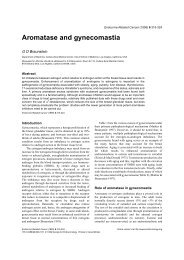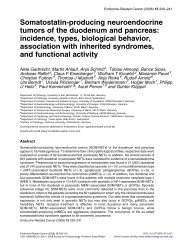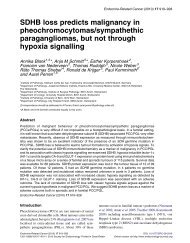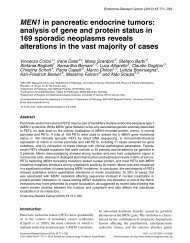Management of risk of breast carcinoma in postmenopausal women
Management of risk of breast carcinoma in postmenopausal women
Management of risk of breast carcinoma in postmenopausal women
Create successful ePaper yourself
Turn your PDF publications into a flip-book with our unique Google optimized e-Paper software.
Biglia et al.: Breast <strong>carc<strong>in</strong>oma</strong> <strong>in</strong> <strong>postmenopausal</strong> <strong>women</strong><br />
Figure 3 Risk estimates for death from <strong>breast</strong> cancer and <strong>breast</strong> cancer survival: ever users compared with never users <strong>of</strong> HRT<br />
(estrogen plus progest<strong>in</strong>) (modified from Bush et al. 2001).<br />
menopause on quality <strong>of</strong> life should be considered and<br />
discussed with the patient.<br />
Chemoprevention<br />
In 1998, results from the National Surgical Adjuvant<br />
Breast and Bowel Project-Breast Cancer Prevention Trial<br />
(NSABP-BCPT) (Fisher et al. 1998) led to Food and<br />
Drug Adm<strong>in</strong>istration approval <strong>of</strong> the use <strong>of</strong> tamoxifen for<br />
the chemoprevention <strong>of</strong> <strong>breast</strong> cancer <strong>in</strong> healthy <strong>women</strong><br />
at high <strong>risk</strong>. This study showed a 50% <strong>risk</strong> reduction <strong>of</strong><br />
<strong>in</strong>vasive <strong>carc<strong>in</strong>oma</strong> and ductal <strong>carc<strong>in</strong>oma</strong> <strong>in</strong> situ (DCIS)<br />
<strong>in</strong> the group treated for 5 years with 20 mg tamoxifen/day<br />
as compared with controls. This reduction was observed<br />
for all age groups and was significant for <strong>women</strong> with<br />
previous diagnosis <strong>of</strong> lobular <strong>carc<strong>in</strong>oma</strong> <strong>in</strong> situ (LCIS)<br />
and atypical hyperplasia or <strong>in</strong> <strong>women</strong> with a family<br />
history <strong>of</strong> <strong>breast</strong> cancer; the protective effect was limited<br />
to tumors with positive estrogen receptors. Among the<br />
favorable events, a 19% reduction <strong>in</strong> osteoporotic<br />
fractures was reported <strong>in</strong> the group tak<strong>in</strong>g tamoxifen.<br />
Incidence <strong>of</strong> myocardial <strong>in</strong>farction was the same <strong>in</strong> the<br />
two groups, but there was an excess <strong>of</strong> deep venous<br />
thrombosis <strong>in</strong> <strong>postmenopausal</strong> <strong>women</strong> and an <strong>in</strong>creased<br />
<strong>risk</strong> <strong>of</strong> endometrial <strong>carc<strong>in</strong>oma</strong> (RR = 2.5) <strong>in</strong> the treated<br />
group compared with the placebo group.<br />
Results <strong>of</strong> the BCPT study were not confirmed by two<br />
European studies (Powles et al. 1998, Veronesi et al.<br />
1998). Many reasons can expla<strong>in</strong> this discrepancy: the<br />
small numbers <strong>of</strong> events (70 <strong>in</strong> the English study, 49 <strong>in</strong> the<br />
Italian study), different eligibility criteria, the higher<br />
proportion <strong>of</strong> <strong>carc<strong>in</strong>oma</strong>s with negative estrogen<br />
receptors <strong>in</strong> the European studies as compared with the<br />
BCPT trial and the high drop-out rate. Furthermore,<br />
<strong>women</strong> tak<strong>in</strong>g HRT were excluded from the BCPT trial,<br />
while 41% <strong>of</strong> <strong>women</strong> <strong>in</strong> the UK study and 14% <strong>in</strong> the<br />
Italian study were tak<strong>in</strong>g hormones for menopausal<br />
symptoms, together with tamoxifen. Veronesi et al. 1998<br />
observed a significant reduction <strong>in</strong> number <strong>of</strong> <strong>breast</strong><br />
cancers <strong>in</strong> the group treated with tamoxifen compared<br />
with the placebo group (6 cases vs 17) only <strong>in</strong> the<br />
subgroup <strong>of</strong> <strong>women</strong> who had also taken HRT. This<br />
encouraged Italian researchers to beg<strong>in</strong> a new trial to<br />
evaluate the efficacy <strong>of</strong> tamoxifen at low doses (5 mg/day)<br />
<strong>in</strong> prevent<strong>in</strong>g <strong>breast</strong> <strong>carc<strong>in</strong>oma</strong> <strong>in</strong> healthy <strong>postmenopausal</strong><br />
<strong>women</strong> treated with every k<strong>in</strong>d <strong>of</strong> HRT for problems<br />
related to the menopause (HRT Opposed to Low-dose<br />
Tamoxifen Study (HOT Study)) (Veronesi et al. 2002).<br />
The IBIS trial confirmed the effectiveness <strong>of</strong> tamoxifen <strong>in</strong><br />
reduc<strong>in</strong>g the <strong>in</strong>cidence <strong>of</strong> <strong>breast</strong> cancer <strong>in</strong> healthy <strong>women</strong>.<br />
The <strong>in</strong>vestigators found a reduction <strong>of</strong> 32% <strong>of</strong> <strong>in</strong>vasive<br />
<strong>breast</strong> cancers and DCIS <strong>in</strong> the tamoxifen group;<br />
<strong>in</strong>terest<strong>in</strong>gly they also reported that <strong>women</strong> tak<strong>in</strong>g HRT<br />
and tamoxifen had fewer unfavorable endometrial and<br />
76 www.endocr<strong>in</strong>ology.org






